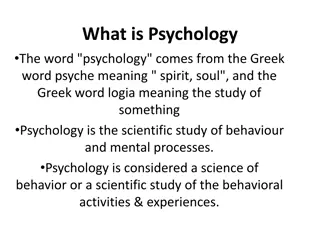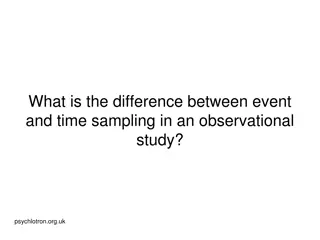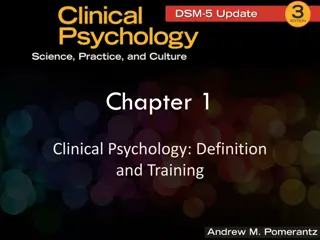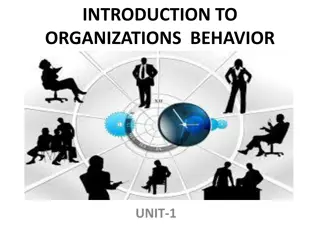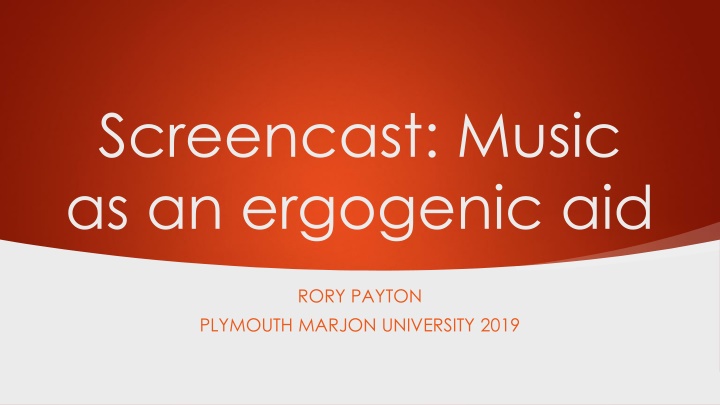
Harnessing Music as an Ergogenic Tool in Sports Performance
Explore the impact of music on athletic performance, from mood enhancement to physiological effects. Discover how prescribing music can benefit athletes, considerations for mood and dissociative psychology in exercise, and the concept of flow for optimal performance.
Download Presentation

Please find below an Image/Link to download the presentation.
The content on the website is provided AS IS for your information and personal use only. It may not be sold, licensed, or shared on other websites without obtaining consent from the author. If you encounter any issues during the download, it is possible that the publisher has removed the file from their server.
You are allowed to download the files provided on this website for personal or commercial use, subject to the condition that they are used lawfully. All files are the property of their respective owners.
The content on the website is provided AS IS for your information and personal use only. It may not be sold, licensed, or shared on other websites without obtaining consent from the author.
E N D
Presentation Transcript
Screencast: Music as an ergogenic aid RORY PAYTON PLYMOUTH MARJON UNIVERSITY 2019
Key concepts: Prescribing music: Mood enhancer or myth? Physiological effects: RPE/HR correlation(Karageorghis & Jones, 2014) Use of music in sport: What is the goal? Flow the desirable state of performance (Mirvis & Csikszentmihalyi, 1991)
Prescribing music When prescribing your athlete with music as an ergogenic aid, it is important to consider the desired effects. Here are a few considerations for practitioners: Cultural impact/musicality determining mood/arousal changes Extra-musical connotations to an athlete Rhythm response during exercise E.g. Cycling cadence Adverse mood effects from use of music Inspirational lyrics
Athlete considerations for mood Use of music can have task-associative thoughts and stimulate task- relevant cues in addition to its previous benefits if selected to do so only (Gabana, Van Raalte, Hutchinson, Brewer, & Petitpas, 2015). Mood influencing music should be self-selected to illicit changes in mood, but should be categorised by previously mentioned prescriptive characteristics (Bishop, Karageorghis, & Loizou, 2007). High volume and continuous music can cause hearing damage- Consider volume and length of use when training.
Dissociative psychology in exercise The use of music to dull pain or fatigue psychologically is common in recreational sport or training, and can be used in elite performers to reduce perceived exertion. This phenomena has been repeatedly found in research during sport, with reduction in RPE being more common than changes in performance. As a practitioner, you can utilise this to increase the intensity or volume of the training slightly to stimulate more physiological adaptations. Development for psychological endurance and mental toughness?
Flow; Physiological and psychological performance perfection You have heard about how a musician loses herself in her music, how a painter becomes one with the process of painting. In work, sport, conversation or hobby, you have experienced, yourself, the suspension of time, the freedom of complete absorption in activity. This is "flow," an experience that is at once demanding and rewarding- an experience (Mirvis & Csikszentmihalyi, 1991) Applications of flow: Improved mood, Arousal control, reduced perceived exertion, enhanced work output, Improved basic motor skill acquisition and dissociation from feelings of pain and fatigue.
Psychological benefits of music- How and why? Though research into purely physiological factors of sport are rare, few do exist, answering the question of how your athlete s mood and perceived exertion are decreased. Here is a brief explanation (sci-fi language warning!): The brain s electrical activity (Specifically beta-waves) are up- regulated and restricted to locations that stimulate task-irrelevant thoughts, inhibiting internal sensory reactions. This restriction of beta- waves also appears to promote positive emotional states, arousal increases and perceived enjoyment of sport performance. To maximise these benefits, synchronous music should be selected, as it shows slightly higher reliability in research. (Bigliassi, Karageorghis, Hoy, & Layne, 2019)
Physiology: Mind over matter? Although music is thought of as a purely mental aid, research from (Terry, Karageorghis, Saha, & D Auria, 2012) suggests that running economy and oxygen consumption are linked to music: Their work shows a 7% decrease in oxygen consumption when listening to any music, and Blood lactate concentrations were lower in motivational music. Finally, time to exhaustion was 18-20% higher in music groups, with contributions from both physiological and psychological benefits accounted for. Further work shows anaerobic sprint performance can also be increased with music, validating its use in anaerobic events (Simpson & Karageorghis, 2006).
Health considerations: Salivary IgA (immune system strength) has been shown to increase by 20% when listening to music of any type (Boutcher & Trenske, 1990). Exercise referral and enjoyment increases in recreational athletes due to external stimuli, which can be applied to athletes in painful training regimes (Razon, Basevitch, Land, Thompson, & Tenenbaum, 2009). Music can be used in recovery of injured athletes, but is unlikely to increase recovery speed. However, it may reduce perceived fatigue, pain, burnout and frustration with rehabilitation periods.
Final verdict: Is music for your athlete? Music is an effective ergogenic aid both for the increase of performance based on task-relevant behaviours and dissociative psychology, but should be moderated to ensure your athlete gains all associated benefits. In this regard, it acts as any other ergogenic aid, and should be considered one by practitioners, both in terms of safety precautions and effective sustainable benefits.
References: Bigliassi, M., Karageorghis, C. I., Hoy, G. K., & Layne, G. S. (2019). The Way You Make Me Feel: Psychological and cerebral responses to music during real-life physical activity. Psychology of Sport and Exercise. https://doi.org/10.1016/j.psychsport.2018.01.010 Bishop, D. T., Karageorghis, C. I., & Loizou, G. (2007). A grounded theory of young tennis players use of music to manipulate emotional state. Journal of Sport & Exercise Psychology. Boutcher, S. H., & Trenske, M. (1990). Music and Morale Music and Health. Journal of Sport and Exercise Psychology. Gabana, N. T., Van Raalte, J. L., Hutchinson, J. C., Brewer, B. W., & Petitpas, A. J. (2015). The Effects of Music and a Coxswain on Attentional Focus, Perceived Exertion, Motivation, and Performance During a 1,000 m Ergometer Rowing Sprint. Journal of Applied Sport Psychology. https://doi.org/10.1080/10413200.2014.993775 Karageorghis, C. I., & Jones, L. (2014). On the stability and relevance of the exercise heart rate-music-tempo preference relationship. Psychology of Sport and Exercise. https://doi.org/10.1016/j.psychsport.2013.08.004 Mirvis, P. H., & Csikszentmihalyi, M. (1991). Flow: The Psychology of Optimal Experience. The Academy of Management Review. https://doi.org/10.2307/258925 Razon, S., Basevitch, I., Land, W., Thompson, B., & Tenenbaum, G. (2009). Perception of exertion and attention allocation as a function of visual and auditory conditions. Psychology of Sport and Exercise. https://doi.org/10.1016/j.psychsport.2009.03.007 Simpson, S. D., & Karageorghis, C. I. (2006). The effects of synchronous music on 400-m sprint performance. Journal of Sports Sciences. https://doi.org/10.1080/02640410500432789 Terry, P. C., Karageorghis, C. I., Saha, A. M., & D Auria, S. (2012). Effects of synchronous music on treadmill running among elite triathletes. Journal of Science and Medicine in Sport. https://doi.org/10.1016/j.jsams.2011.06.003








